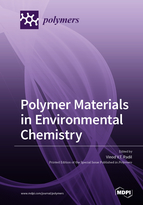Polymer Materials in Environmental Chemistry
A special issue of Polymers (ISSN 2073-4360). This special issue belongs to the section "Polymer Applications".
Deadline for manuscript submissions: closed (31 August 2020) | Viewed by 66301
Special Issue Editor
Interests: tree gum polymers; nanoparticles; electrospinning; bioremediation; bioplastics; green synthesis; environmental chemistry
Special Issues, Collections and Topics in MDPI journals
Special Issue Information
Dear Colleagues,
Polymeric materials have been surveyed for food, pharmaceutical, medical, and industrial sectors. However, the development of polymeric materials, in both synthetic and natural forms with gauging stability, high mechanical and thermal properties, electrospinning characteristics, and sustainability, etc., are expected to play crucial roles in many important areas of research. The broader scientific community will be the beneficiary of the newer knowledge-based information about electrospun polymeric fibers, development of sponges via self-assembly of polymers, films formation, etc., and the application of these functionalized polymers in many diverse fields with properties and surface morphology, high mechanical attributes, etc., and will be the main highlights.
The current Special Issue has the potential of strongly influencing the emerging and burgeoning fields of polymeric materials from natural or synthetic sources and their diverse applications in the environmental field. The latest advancements of polymeric materials in the form of composites, fibers, sponges, films, etc. and their applications such as environmental bioremediation, water purification, anti-microbial, biosensor, catalytic, and tissue engineering to the present challenges will be highlighted with future possibilities in this current Special Issue.
This Special Issue emphasizes the current importance of polymeric materials in an ever-expanding field. Also highlighted are the implications for the wider scientific community; the appeal to a larger audience (in the fields of chemistry, physics, biology, medicine and environmental science, as well as in the pharmaceutical, biotechnological and nanotechnological arenas).
Dr. Vinod V.T. Padil
Guest Editor
Manuscript Submission Information
Manuscripts should be submitted online at www.mdpi.com by registering and logging in to this website. Once you are registered, click here to go to the submission form. Manuscripts can be submitted until the deadline. All submissions that pass pre-check are peer-reviewed. Accepted papers will be published continuously in the journal (as soon as accepted) and will be listed together on the special issue website. Research articles, review articles as well as short communications are invited. For planned papers, a title and short abstract (about 100 words) can be sent to the Editorial Office for announcement on this website.
Submitted manuscripts should not have been published previously, nor be under consideration for publication elsewhere (except conference proceedings papers). All manuscripts are thoroughly refereed through a single-blind peer-review process. A guide for authors and other relevant information for submission of manuscripts is available on the Instructions for Authors page. Polymers is an international peer-reviewed open access semimonthly journal published by MDPI.
Please visit the Instructions for Authors page before submitting a manuscript. The Article Processing Charge (APC) for publication in this open access journal is 2700 CHF (Swiss Francs). Submitted papers should be well formatted and use good English. Authors may use MDPI's English editing service prior to publication or during author revisions.
Keywords
- Synthetic polymers
- natural polymers
- polymeric composites
- electrospun fibers
- sponges and films
- hydrogel
- polymeric sensors
- polymeric nanoparticles
- water and wastewater treatments
- polymer catalysis







